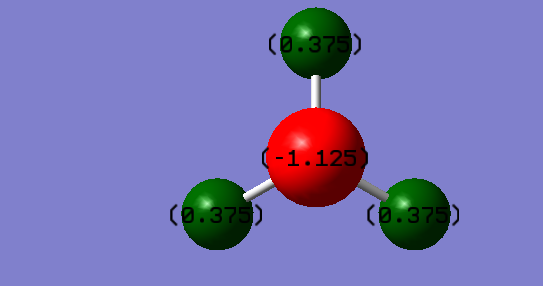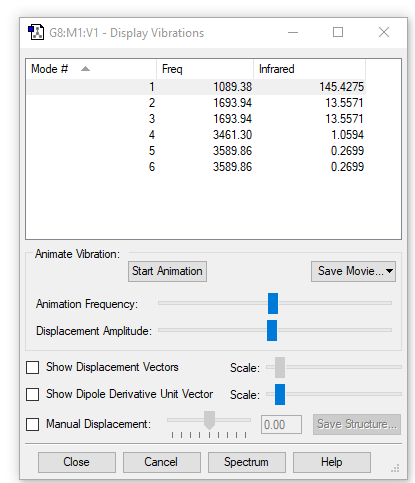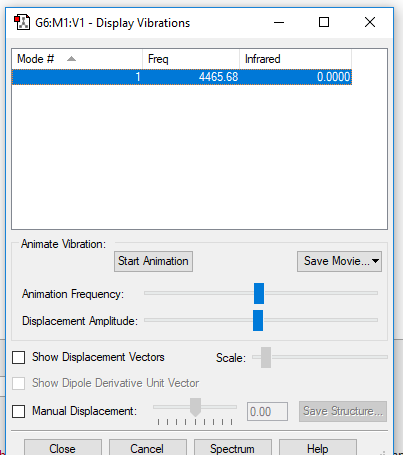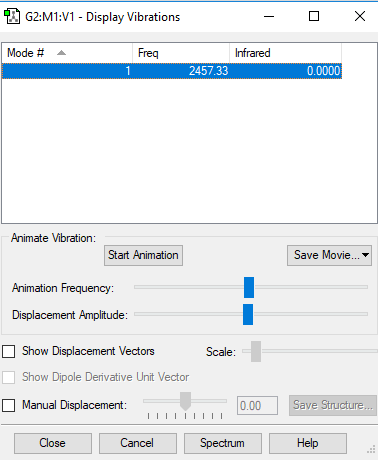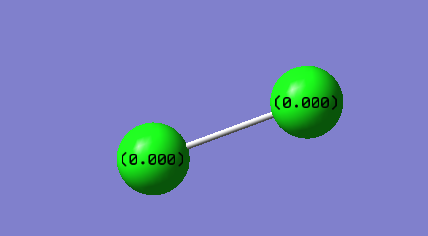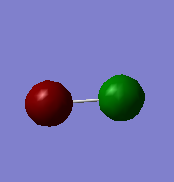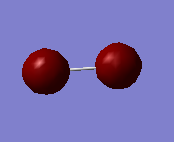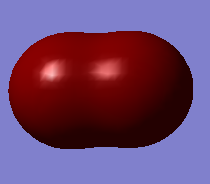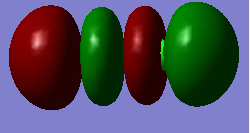Hz7718
NH3
NH3 |
Link to .log file
| NH3 | |
|---|---|
| optimised bond length | 1.018 A |
| optimised bond angle | 105.745 degree |
| calculation method | RB3LYP |
| basis set | 6-31G(d,p) |
| final energy | -56.55776873 a.u. |
| RMS gradient | 0.00000323 a.u. |
| point group | C3V |
| Item | Value | Threshold | Converged? | |
| Maximum | Force | 0.000006 | 0.000450 | YES |
| RMS | Force | 0.000004 | 0.000300 | YES |
| Maximum | Displacement | 0.000014 | 0.001800 | YES |
| RMS | Displacement | 0.000009 | 0.001200 | YES |
| Expected Charge | Charge Analysed | |
| N | Negative | -1.125 |
| H | Positive | +0.375 |
| Because N has larger electron negativity, so it will attract electrons from H atoms and become more negative. |
| Mode | Frequency/cm^-1 | Intensity | Symmetry? |
| 1 | 1089 | 145 | YES |
| 2 | 1693 | 13 | NO |
| 3 | 1693 | 13 | NO |
| 4 | 3461 | 1 | YES |
| 5 | 3589 | 0 | NO |
| 6 | 3589 | 0 | NO |
| 6 modes expected |
| Mode 2 and 3 are degenerated(frequency 1693.94), Mode 5 and 6 are degenerated(frequency 3589.86) |
| bending vibration: Mode 1,2 and 3 |
| stretching vibration: Mode 4,5 and 6 |
| Highly symmetric Mode: 4 |
| Umbrella Mode: 1 |
| 3 bands are expected to see in spectrum |
H2
H2 |
Link to .log file
| H2 | |
|---|---|
| optimised bond length | 0.74279 A |
| optimised bond angle | 180.0 degree |
| calculation method | RB3LYP |
| basis set | 6-31G(d,p) |
| final energy | -1.17853936 a.u. |
| RMS gradient | 0.00000017 a.u. |
| point group | D*H |
| Item | Value | Threshold | Converged? | |
| Maximum | Force | 0.000000 | 0.000450 | Yes |
| RMS | Force | 0.000000 | 0.000300 | YES |
| Maximum | Displacement | 0.000000 | 0.001800 | YES |
| RMS | Displacement | 0.000001 | 0.001200 | YES |
| Expected Charge | Charge Analysed | |
| H1 | 0.000 | 0.000 |
| H2 | 0.000 | 0.000 |
| Mode | Frequency/cm^-1 | Intensity | symmetry? |
| 1 | 4465 | 0 | YES |
| 1 modes expected |
| stretching vibration: Mode 1(frequency 4465.68) |
| Highly symmetric Mode: 1 |
| 0 bands are expected to see in spectrum |
N2
N2 |
Link to .log file
| N2 | |
|---|---|
| optimised bond length | 1.10550 A |
| optimised bond angle | 180.0 degree |
| calculation method | RB3LYP |
| basis set | 6-31G(d,p) |
| final energy | -109.52412868 a.u. |
| RMS gradient | 0.00000060 a.u. |
| point group | D*H |
| Item | Value | Threshold | Converged? | |
| Maximum | Force | 0.000001 | 0.000450 | Yes |
| RMS | Force | 0.000001 | 0.000300 | YES |
| Maximum | Displacement | 0.000000 | 0.001800 | YES |
| RMS | Displacement | 0.000000 | 0.001200 | YES |
| Expected Charge | Charge Analysed | |
| N1 | 0.000 | 0.000 |
| N2 | 0.000 | 0.000 |
| Mode | Frequency/cm^-1 | Intensity | symmetry? |
| 1 | 2457 | 0 | YES |
| 1 modes expected |
| stretching vibration: Mode 1(frequency 2457.33 cm^-1) |
| Highly symmetric Mode: 1 |
| 0 bands are expected to see in spectrum |
Structure and Reactivity
| In the crystal structure of DENQET, the bond length of H2 is 1.131, which is longer than the optimised |
| Reason 1: The bond length of H2 is measured by GaussView theoretically, not always the true value. |
| Reason 2: The bond length of H2 in has different environment with H2 in GaussView, the complex metal ion will withdraw the electron density from the ligand H2, then the bond strength declines. So the bond length will increase. |
| Reason 3: The GaussView measure the H2 in gaseous state, but the DENQET is in solid state. |
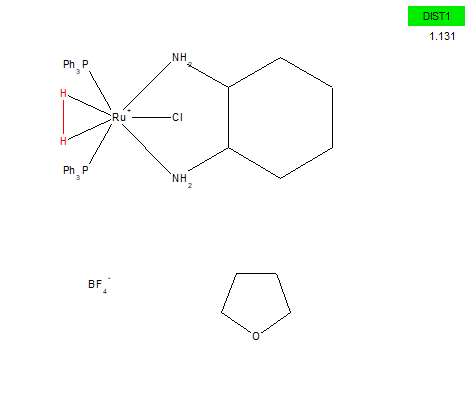
| Energy | |
|---|---|
| E(NH3) | -148492.43 kJ/mol |
| 2*E(NH3)= | -296984.86 kJ/mol |
| E(N2)= | -287555.62 kJ/mol |
| E(H2)= | -3094.26 kJ/mol |
| 3*E(H2)= | -9282.78 kJ/mol |
| ΔE=2*E(NH3)-[E(N2)+3*E(H2)] | -146.46 kJ/mol |
| Because the energy needed is negative, which means this is a exothermic reaction, the ammonia product is more stable. |
Cl2
Cl2 |
Link to .log file
| Cl2 | |
|---|---|
| optimised bond length | 2.04162 A |
| optimised bond angle | 180.0 degree |
| calculation method | RB3LYP |
| basis set | 6-31G(d,p) |
| final energy | -920.34987887 a.u. |
| RMS gradient | 0.00000326 a.u. |
| point group | D*H |
| Item | Value | Threshold | Converged? | |
| Maximum | Force | 0.000006 | 0.000450 | Yes |
| RMS | Force | 0.000006 | 0.000300 | YES |
| Maximum | Displacement | 0.000016 | 0.001800 | YES |
| RMS | Displacement | 0.000022 | 0.001200 | YES |
| Expected Charge | Charge Analysed | |
| Cl1 | 0.000 | 0.000 |
| Cl2 | 0.000 | 0.000 |
| Mode | Frequency/cm^-1 | Intensity | symmetry? |
| 1 | 520.47 | 0.000 | YES |
| 1 modes expected |
| stretching vibration: Mode 1(frequency 520.47 cm^-1) |
| Highly symmetric Mode: 1 |
| 0 bands are expected to see in spectrum |
Molecular Orbital
| This is a core molecular orbital, its energy is -9.51829 a.u. It is occupied and it is formed by 2S orbitals. It does not do contribution to the bonding of the molecule. |
| This is a core molecular orbital, its energy is -9.51828 a.u. It is occupied and it is formed by 2S orbitals. It does not do contribution to the bonding of the molecule. |
| This is a bonding molecular orbital, its energy is -0.93315 a.u. It is occupied and it is formed by 3S orbitals. It contributes to the bond forming. |
| This is an anti-bonding molecular orbital, its energy is -0.77745 a.u. It is occupied and it is formed by 3S orbitals. |
| This is an anti-bonding molecular orbital, its energy is -0.14203 a.u. It is unoccupied and it is formed by 3p orbitals, and it is the HOMO. |
Comparison
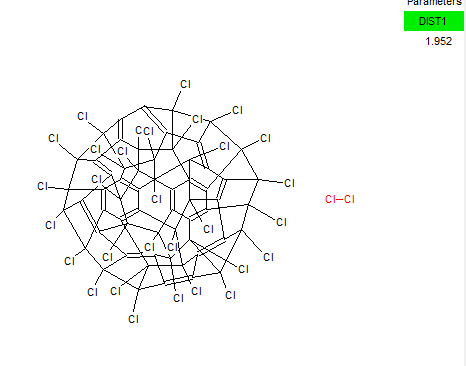
| The bond length of Cl2 in FECMON is smaller the the optimised value. Because it is in solid state in FECMON, the bond strength is larger and the bond length is smaller. |
Marking
Note: All grades and comments are provisional and subjecct to change until your grades are officially returned via blackboard. Please do not contact anyone about anything to do with the marking of this lab until you have recieved your grade from blackboard.
Wiki structure and presentation 1/1
Is your wiki page clear and easy to follow, with consistent formatting?
YES - you could have included more subsections and ordered your results a bit better
Do you effectively use tables, figures and subheadings to communicate your work?
YES
NH3 0.5/1
Have you completed the calculation and given a link to the file?
YES
Have you included summary and item tables in your wiki?
YES
Have you included a 3d jmol file or an image of the finished structure?
YES
Have you included the bond lengths and angles asked for?
YES
Have you included the “display vibrations” table?
YES
Have you added a table to your wiki listing the wavenumber and intensity of each vibration?
YES
Did you do the optional extra of adding images of the vibrations?
YES
Have you included answers to the questions about vibrations and charges in the lab script?
YES, however instead of 3 bands 2 are expected in an experimental spectrum. You stated two sets of degenerate vibrations correctly. This reduces the number of bands to 4. Taking into account the low intensities of the stretching vibrations only 2 bands are expected.
N2 and H2 0/0.5
Have you completed the calculations and included all relevant information? (summary, item table, structural information, jmol image, vibrations and charges)
YES, you could have explained that the charges are 0 as the electronegativities are equal. You stated bond angles for N2 and H2. To define a bond angle a minimum of 3 atoms is needed!
Crystal structure comparison 0.5/0.5
Have you included a link to a structure from the CCDC that includes a coordinated N2 or H2 molecule?
YES
Have you compared your optimised bond distance to the crystal structure bond distance?
YES
Haber-Bosch reaction energy calculation 1/1
Have you correctly calculated the energies asked for? ΔE=2*E(NH3)-[E(N2)+3*E(H2)]
YES
Have you reported your answers to the correct number of decimal places?
YES
Do your energies have the correct +/- sign?
YES
Have you answered the question, Identify which is more stable the gaseous reactants or the ammonia product?
YES
Your choice of small molecule 4/5
Have you completed the calculation and included all relevant information?
YES
Have you added information about MOs and charges on atoms?
You could have explained the charges using an electronegativity argument. You missed to use the term of non-bonding for. the first two MOs. You missed to explain the influence of the last two MOs on the bonding situation.
Independence 1/1
If you have finished everything else and have spare time in the lab you could: Check one of your results against the literature, or
YES - a bit short but that is what was requested.
Do an extra calculation on another small molecule, or Do some deeper analysis on your results so far

